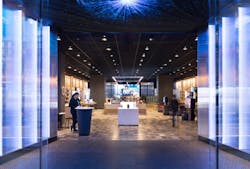Iteration vs disruption: Designing for a great customer experience
What does innovation even mean anymore? For the past decade, at least, innovation has been a catch-all for that ‘special sauce’ that gets companies to act first on the newest technologies or the newest market opportunities. When most retailers are talking about innovation, they are typically just talking about iteration. For retailers, iteration translates to arming employees with iPads, relocating the cash wrap, updating spaces with new paint—in other words, refreshing an experience that from the consumer’s perspective is essentially the same. This is a reactive response for how to solve for today, not a proactive solution for how to solve for the future. To be truly innovative, retailers should be talking about disruption, not iteration.
One way to solve for the future is to disrupt the expected. In today’s experience-based economy, creating a good experience is not enough; the best places, ones that engage people’s emotions and keep them coming back, have to be great. When the goal is to stand out from the crowd, the power of the physical place to create this great experience cannot be denied. Take Comcast’s Studio Xfinity store, an experiential retail concept in Washington, DC. Customers who might enter the store searching for a new modem can grab a latte at the La Colombe coffee bar, test products, or attend lectures or film nights in the store’s “product-free” zone. The Xfinity flagships are designed to serve as community hubs—upending some consumers’ perceptions of a typical cable company and repositioning the entertainment provider as a lifestyle brand. Now that’s disruption.
Curating a customized experience
For today’s consumers, online and in-store experiences represent the same brand but as different touch points. The purpose of the physical stores has shifted from transaction to engagement and connection. Simply put, stores offer opportunities to create emotional engagement and connect customers with their brand in a way that shopping online simply cannot.
According to the Gensler Experience Index: Retail, the nature in which a product is displayed has a significant impact on the quality and value a person will attribute to that product.
Technology has the potential to form a strong impression—customers expect the physical store to employ and embed the latest technology and presume that in-store content will be managed at the pace of change they see in the world. Technology for its own sake can miss the mark, particularly if the content goes stale or doesn't help people get their tasks done. If it is not functioning correctly, technology can be a very expensive mistake. Nothing looks worse to a customer than large blank screens!
According to the Gensler Experience Index: Retail, consumers expect in-store technology to be fresh—and their experience suffers if they think it’s stale.
While nothing can replace the authenticity of an analog experience, the benefits of utilizing technology to curate a customized experience go hand in hand. By being purposeful, technology has the potential to help enable an experience based on the need. Look no further than Cadillac House. This bricks-and-mortar facility is the realization of a shifting marketing strategy for the brand: open, dynamic, and contemporary with highly integrated technology, where visitors can fully experience the Cadillac portfolio. This type of experience is disrupting automotive retail, and technology is a key component to the overall experience. A successful in-store experience does not necessarily need to blend both analog and digital technology. Cool tech isn't the only way to engage with customers. It’s about finding ways to be more present in their daily routines and giving people a specific reason to come and visit.
For the Cadillac House NYC Experience Center, Gensler built on the existing architecture, cladding columns in technology to create a digital canvas that activates the space day and night. The runway and media strategy can also support fashion events, brand collaborations, movie premiers. and other partnerships. Image © Eric Laignel.
About the Author
Gensler
A global design firm with more than 5,000 practitioners networked across five continents, Gensler features insights and opinions of architects and designers on how design innovation makes cities more livable, work smarter, and leisure more engaging. Our contributors write about projects of every scale, from refreshing a retailer’s brand to planning a new urban district, all the while explaining how great design can optimize business performance and human potential. For more thought leadership and blog content, visit our Research & Insight page. Follow us on Facebook, LinkedIn, and Twitter.
